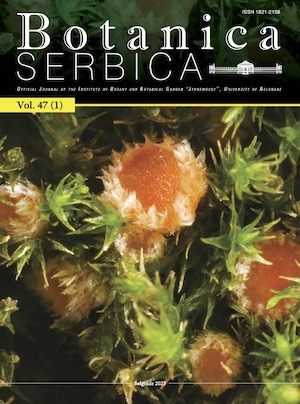
Volume 47 Issue 1 2023 |
Persicaria amphibia, an old traditional remedy and wild edible herb: in vitro evaluation of cytotoxicity and antimicrobial properties
|
KEY WORDS: Persicaria amphibia, doxorubicin, Nrf2 gene expression, antimicrobial activity, quorum sensing, diet-derived therapy |
A contribution to the knowledge of Amanita coryli (Amanitaceae, Agaricales)
|
KEY WORDS: Amanita Sect. Vaginatae, Amanitopsis, biogeography, mycota of Southeastern Europe, taxonomy |
Phytochemical analysis and biological activities of Salvia candidissima subsp. candidissima mericarps
|
KEY WORDS: Salvia candidissima subsp. candidissima, mericarp, chemical content, DPPH, antimicrobial activity, antibiofilm activity |
Chemical analysis and biological activity of the essential oils and extracts of two liverwort species growing in Turkey
|
KEY WORDS: Diplophyllum taxifolium, Diplophyllum albicans, oil composition, GC/FID/ MS, biological evaluation, phenolic constituents, HPLC-UV |
Geastrum juliae (Geastrales, Agaricomycetes), a new species from the Russian Far East
|
KEY WORDS: earthstars, gasteroid fungi, Gasteromycetes, ITS nrDNA, molecular identification, taxonomy |
Three Sphagnum taxa new to Turkey and South-West Asia
|
KEY WORDS: biodiversity, Bryophyte, peat mosses, new record |
Pseudoxenochalara gen. nov. (Dermateaceae, Helotiales), with P. grumantiana sp. nov. from the Svalbard archipelago
|
KEY WORDS: Dermateaceae, Helotiales, multi-gene phylogeny, Arctic tundra, Svalbard |
New epiphytic bryophyte communities from Turkey
|
KEY WORDS: bryophyte, epiphytic vegetation, Kümbet Plateau, Turkey |
Assessment of the botanical origin of Bulgarian honey samples using melissopalynological, DNA barcoding and NMR analyses
|
KEY WORDS: rbcL, bee honey, melissopalynology, 1H and 13C NMR |
The effect of the Satureja montana ethanol extract on the morphological changes of erythrocytes
|
KEY WORDS: winter savory, plant extract, antioxidant activity, blood cells |
The phenolic constituents and antimicrobial activity of Xanthium spinosum (Asteraceae) extracts
|
KEY WORDS: phenolic acids, flavonoids, antifungal activity, antibacterial activity, antibiofilm activity |
The relationship between chlorophyll a fluorescence parameters and yield components in sunflower hybrids
|
KEY WORDS: genotype, leaf temperature, photosynthesis, photosynthetic activity, chlorophyll content, agronomic traits |
Boron toxicity tolerance in barley may be related to intrinsically higher levels of reactive oxygen species in the shoots
|
KEY WORDS: boron toxicity, tolerance mechanisms, barley, reactive oxygen species, antioxidant capacity, compatible solutes |
An insight into seasonal changes of carbohydrates and phenolic compounds within the moss Polytrichum formosum (Polytrichaceae)
|
KEY WORDS: bryophyte, chemical content, climate, sugars, phenolics |
Functional differentiation of two autochthonous cohabiting strains of Pleurotus ostreatus and Cyclocybe aegerita from Serbia in lignin compound degradation
|
KEY WORDS: wood degradation, wood decaying fungi, laccase, Mn peroxidase, lignin peroxidase |
The alpine scrubs and dwarf heaths of the Balkan Peninsula - an exceptional center of floristic richness and endemism
|
KEY WORDS: floristic diversity, endemics, relicts, hotspots, mountains, alpine region, environmental heterogeneity |
New records and noteworthy data of plants, algae and fungi in SE Europe and adjacent regions, 11
|
KEY WORDS: new report, Androsace hedraeantha, Anthracoidea caryophylleae, Cephaloziella baumgartneri, Hamatocaulis vernicosus, Hieracium mrazii, Hydnellum caeruleum, Octospora erzbergeri, Ophrys bertolonii subsp. bertolonii, Ophrys scolopax subsp. cornuta, Ramonda nathaliae, Sheathia confusa, Spiranthes spiralis, Streblotrichum convolutum var. commutatum, Triglochin palustris, Ulota crispula, SE Europe |
New records and noteworthy data of plants, algae and fungi in SE Europe and adjacent regions, 12
|
KEY WORDS: new report, Cryptomarasmius corbariensis, Dicranoweisia cirrata, Equisetum × moorei, Fissidens exilis, Fossombronia caespitiformis, Galanthus reginae-olgae subsp. vernalis, Hildenbrandia rivularis, Juniperus virginiana, Lecanora stenotropa, Linaria pelisseriana, Micarea misella, Parthenocissus quinquefolia, Peltolepis quadrata, Pilosella rhodopea, Spiranthes spiralis, Sticta sylvatica, Taraxacum erythrospermum, SE Europe |
New records and noteworthy data of plants, algae and fungi in SE Europe and adjacent regions, 13
|
KEY WORDS: new report, Allium ampeloprasum, Amanita alseides, Batrachospermum skujae, Blindia acuta, Carex ferruginea, Carex limosa, Convolvulus althaeoides, Fumana aciphylla, Gnomonia geraniimacrorrhizi, Hieracium petrovae, Heribaudiella fluviatilis, Lamium bifidum subsp. bifidum, Leucodon sciuroides var. morensis, Pseudostereodon procerrimus, Ranunculus fontanus, Ricciocarpos natans, Russula griseascens, SE Europe |
Nucleolar number variation in Fritillaria (Liliaceae) taxa from Greece
|
KEY WORDS: karyology, nucleoli, AgNO3, NORs, Greek endemics |
List of reviewers for Botanica Serbica in 2022 — Acknowledgements
|


